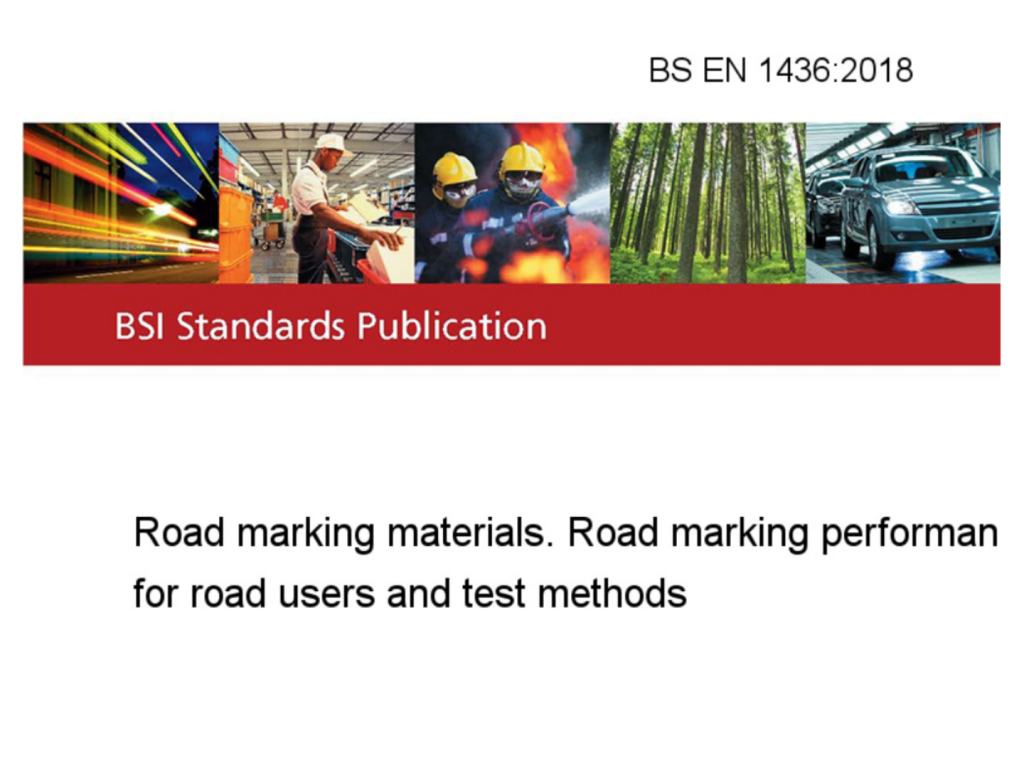BS EN 1436:2018
Road marking materials - Road marking performance for road users and test methods
Introduction
Road markings together with road studs form the means for horizontal signalization.
Road markings include longitudinal markings, arrows, transverse markings, text and symbols on the surface of the highway, etc. Longitudinal road markings serve among else to delineate the roads, to separate opposing traffic streams and to divide the total road area into sub-areas for different road users. Other road markings serve a range of purposes, among else to indicate the use of driving lanes, full stop and give way, to mark pedestrian crossings and to provide information.
Road markings can be provided by the application of paint, thermoplastic materials or reactive materials, pre-formed lines and symbols or by other means.
Most road markings are white or yellow, but in special cases other colours are used.
Road markings are either permanent or temporary. The functional life of temporary road markings is limited by the duration of the road works. For permanent road markings it is best for reasons of safety to have a functional life that is as long as possible, as limited by the gradual deterioration of performance and the level of service to be provided for the road users.
Road markings can be applied with or without the addition of glass beads/anti-skid materials. With glass beads the retroreflection of the marking is achieved when the marking is illuminated by vehicle headlamps. Anti-skid material improves the skid resistance of the marking.
The retroreflection of a marking, in wet or rainy conditions, can also be enhanced by special properties. The properties can be produced by surface texture (as with structured markings), large glass beads or other means, in the case of surface texture, the passage of wheels can produce acoustic or vibration effects.
The value of a parameter for a particular road marking location is dependant of the surface condition of the road marking, which is influenced by the local conditions, time of the year, traffic ‘history’, weather and other factors. It should be taken into account that the value measured on a particular occasion is not necessarily the average or typical value of that road marking.
This standard cannot be used directly as tender specifications nor test instructions, but needs to be supported by additional papers for such applications. Acceptance criteria in view of measuring uncertainty should be part of such additional papers.
A newly applied road marking may not show its true performance because of excess drop-on materials, an oily water repelling surface or other causes. Measurements of the performance should not take place until the actual performance has been developed, which may take from a couple of days to a couple of weeks depending on the type of road surface, the performance characteristics to be measured and the conditions regarding traffic and weather.

1 Scope
This European Standard specifies the performance for road users of white and yellow road markings, as expressed by their reflection in daylight or under road lighting, retroreflection in vehicle headlamp illumination, colour and skid resistance. Furthermore, the standard specifies test methods and conditions.
2 Normative references
The following documents, in whole or in part, are normatively referenced in this document and are indispensable for its application. For dated references, only the edition cited applies. For undated references, the latest edition of the referenced document (including any amendments) applies.
EN 13036-4, Road and airfield surface characteristics – Test methods – Part 4: Method for measurement of si ip/skid resistance of a surface: The pendulum test
IEC 60050-845:1987, International Electro tech nical Vocabulary – Chapter 845: Lighting】)
ISO 11664-2:2007, Colorimetry – Part 2: CIEstandard illuminants
